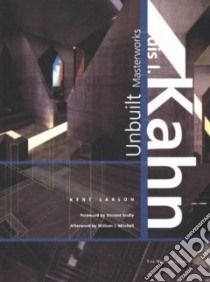Louis I. Kahn - 9781580930147
Un libro in lingua di Kent Larson Scully Vincent Joseph (INT) Kahn Louis I. edito da Random House Inc, 2000
- € 49.80
- Il prezzo è variabile in funzione del cambio della valuta d’origine
American architect Louis I. Kahn left behind a legacy of great buildings: the Salk Institute in La Jolla, California; the Kimbell Art Museum in Fort Worth, Texas; and the Indian Institute for Management in Ahmedabad. Yet he also left behind an equally important legacy of designs that were never realized. This exceptional volume unites those unbuilt projects with the most advanced computer-graphics technology—the first fundamentally new tool for studying space since the development of perspective in the Renaissance—to create a beautiful and poignant vision of what might have been.
Author Kent Larson has delved deep into Kahn's extensive archives to construct faithful computer models of a series of proposals the architect was not able to build: the U.S. Consulate in Luanda, Angola; the Meeting House of the Salk Institute in La Jolla; the Mikveh Israel Synagogue in Philadelphia; the Memorial to Six Million Jewish Martyrs in New York City; three proposals for the Hurva Synagogue in Jerusalem; and the Palazzo dei Congressi in Venice. The resulting computer-generated images present striking views of real buildings in real sites. Each detail is exquisitely rendered, from complex concrete textures to subtle interreflections and patterns of sunlight and shadow.
Kahn's famous statement—"I thought of wrapping ruins around buildings"—is borne out by the views of his unbuilt works; his rigorous exploration of tactility and sensation, light and form, is equally evident. Complementing the new computer images is extensive archival material—rough preliminary drawings, finely delineated plans, and beautiful travel sketches. Larson also presents fascinating documentation of each project, often including correspondence with the clients that shows not only the deep respect accorded the architect but the complicated circumstances that sometimes made it impossible to bring a design to fruition. Not only a historical study of Kahn's unbuilt works, this volume is in itself an intriguing alternative history of architecture.
Informazioni bibliografiche
- Titolo del Libro in lingua: Louis I. Kahn
- Sottotitolo: Unbuilt Masterworks
- Lingua: English
- Autori : Kent Larson Scully Vincent Joseph (INT) Kahn Louis I.
- Editore: Random House Inc
- Collana: Random House Inc (Hardcover)
- Data di Pubblicazione: 01 Gennaio '00
- Genere: ARCHITECTURE
- Argomenti : Architectural drawing United States 20th century
- Pagine: 232
- Dimensioni mm: 285 x 228 x 31
- ISBN-10: 158093014X
- EAN-13: 9781580930147


